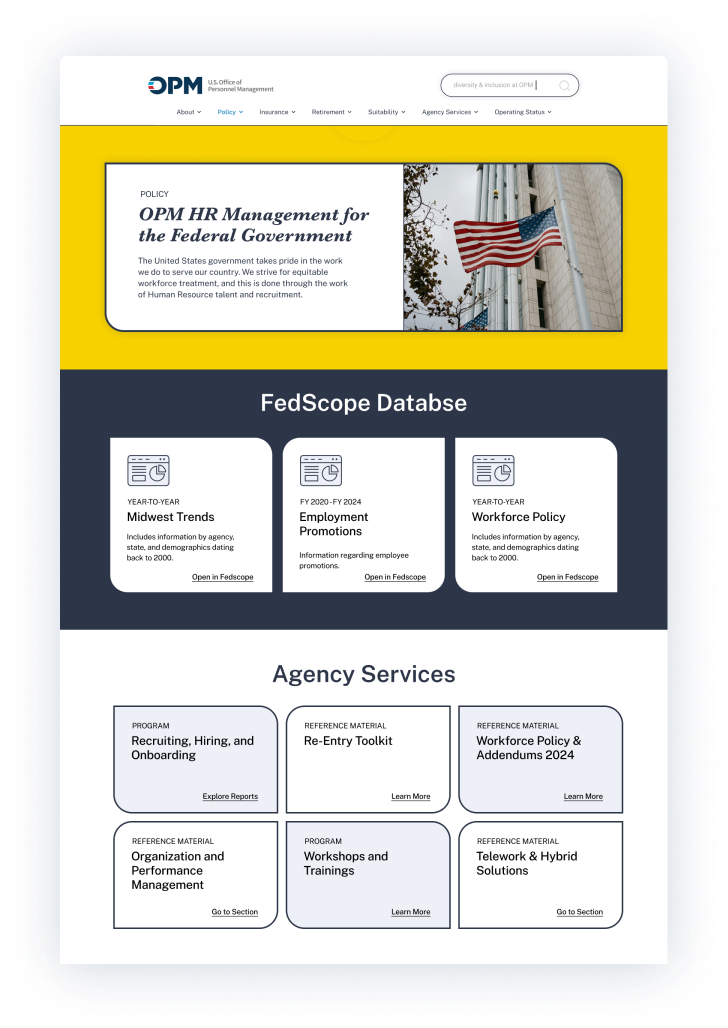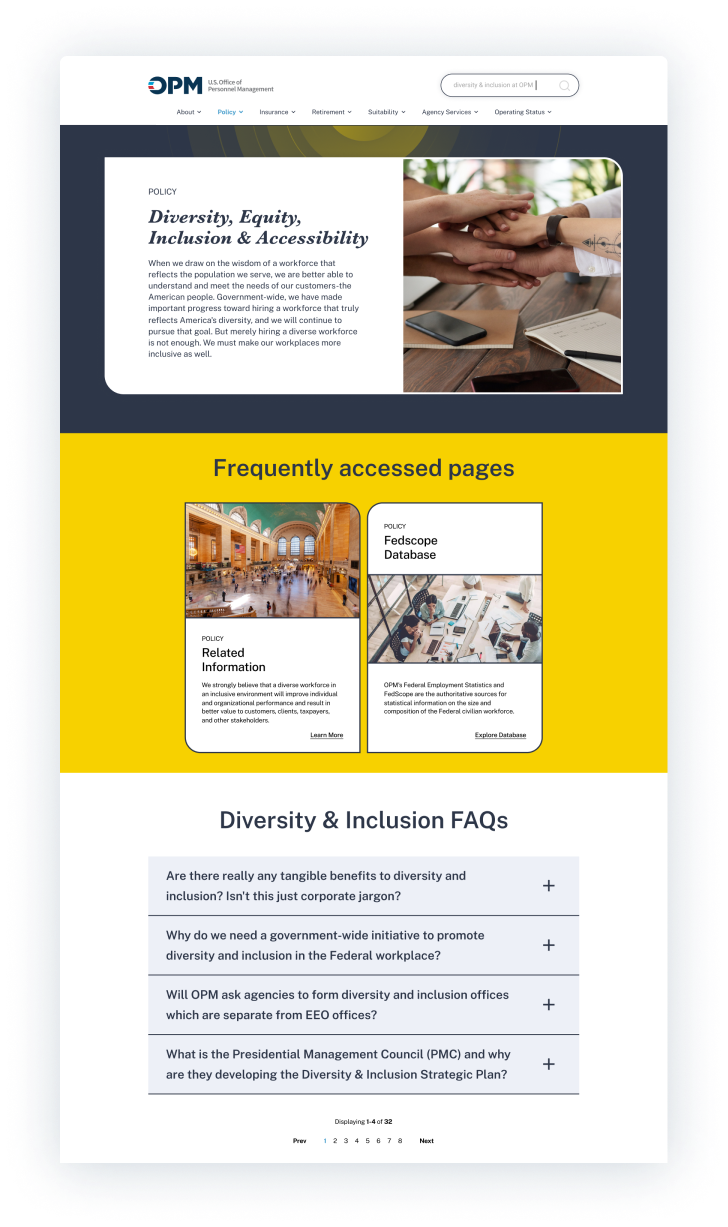Client
The Office of Personnel Management
Role
Research & Product Design
Team
Bhavana Veeravalli

What if generative AI is used for search on a government website—the U.S. Office of Personnel Management? What if it could anticipate user needs? This project uses Evolutionary Generative Adversarial Networks (E-GAN) as the information presented through search will evolve with user input.
Office of Personnel Management (OPM) x Ai Predictive Search
Office of Personnel Management (OPM) x Ai Predictive Search
Ai, Product Design, Data-Visualization, Speculative Design
The resulting page is a generated page of the user's defined parameters; rather than finding just a page, the search creates a novel page.
Define Search.
STEP TWO


Customize filters for the results; the related results generated are incorporated in the curated results page.
Define Search.
STEP ONE
STEP THREE
The user can continue to evolve their search and results. Another key feature is Bookmarks to save potentially important searches.
Redefine Parameters As Needed.

PROBLEM STATEMENT
How can OPM use generative AI to manage information search and content management to enhance public adoption and understanding of federal employee data?
PROCESS
But First, Let's Talk About Research.
Evaluating the current OPM website indicates that there is a plethora of information available, but navigation is confusing. As a first-time user navigating this site, I noticed that one of OPM’s Enterprise Human Resource Integration (EHRI) tools, FedScope, was difficult to find and translate into meaningful applications for Human Resource professionals at the federal level.

Ovearchingly, the key take aways include issues with overall site navigation and redundancy of information.
Current OPM Page UX Audit
DISCOVER STAGE
Based on the audit and additional federal governments site research, I had three main questions that guided me through the development of this project.
DEFINE STAGE
Guiding Research Questions

How is search being used with Ai? How can it be unique to the needs of the persona?

How can OPM streamline its data to enhance information search and content management?

What demographic of users will benefit from having OPM content refined with AI intervention?
Goals
Challenges
Needs
-
Detect insights into federal workforce trends using Fedscope.
-
Improve workforce planning, resource allocation, and recruitment strategies.
-
Complex data is difficult to process in raw format.
-
Current navigation and wayfinding confusing with duplicates of information and unclear mental model flow.
-
Adequate training and support to utilize Fedscope Data effectively.
-
Records of previous federal programs in action across states.
-
DEI & A specific information and resources easy to find.

DISCOVER STAGE
Let's Meet
Tara Dumpala.
“As a Diversity, Equity, Inclusion & Accessibility (DEI & A) HR specialist for the Department of Justice, I want to find DEI & A reports throughout the United States on OPM so that I can find growth opportunities for DEI expansion at the federal employee level.”

DEFINE STAGE
Tara's Empathy Matrix
I organized a usability test of OPM's current page. By doing so, I was able to construct an empathy matrix highlighting Tara's triumphs, difficulties, and overall cognitive process. This provided me clear opportunities to delve deeper into what Tara needed most: an overhaul of how her desired information was output in OPM's search.

The findings from Tara's empathy map facilitated the development of her current user journey. In doing so, I identified 4 stages in her day-to-day flow. The part of her flow that grants itself the most impact is in the search and contextualization stage. Targeting this part of her flow will address her frustrations around triaging and consolidating findings.
DEFINE STAGE
User Journey
DEFINE STAGE
User Journey
The findings from Tara's empathy map facilitated the development of her current user journey. In doing so, I identified 4 stages in her day-to-day flow. The part of her flow that grants itself the most impact is in the search and contextualization stage. Targeting this part of her flow will address her frustrations around triaging and consolidating findings.

DEFINE STAGE
Proposed Task Flow
Tara's current user journey shows that her primary obstacle is cognitive overload in navigating the current OPM Page. Additionally, she struggles with tracking her findings in a consolidated space. The best opportunity presents itself in using AI for search.

Understanding Tara's need for anticipatory results and predictive-related searches assisted me in developing initial sketches that guided subsequent iterations of this project's search features. Key features that can be seen are how Tara finds needed information and how the search evolves with her needs. As Tara's primary means of search is through desktop, I began iterations for the web first and then translated that to mobile.
Low Fidelity Mockups
DEVELOP STAGE


INITIAL SEARCH

GENERATOR MODEL
DISCRIMINATOR MODEL




DELIVER STAGE
The Solution: E-GANS
Based on this process, a customized search experience with the help of Evolutionary Generative Adversarial Networks (E-GANS) proves to be the best solution for the situation. In E-GANS, input data is sifted for patterns and trends, and the generative model is trained to generate new examples with the discriminator model classifying the output as fake or real. Once the discriminator model is unable to discern generated examples as fake 50% of the time, this means the generated outputs are plausible. Applying this to OPM's search would help sift through redundant and unnecessary information and consolidate it into various combinations until the discriminator model fails to classify it as fake. The plausible generation of HR personnel information input by Tara will be her unique output as a result of her search parameters.
REFLECTIONS
A Brief Conclusion
This project excited me because of the possibility that AI holds in every industry. It seems like every day, diverse sectors are integrating AI into their workflow–so why shouldn’t the government? What surprised me about this project was the complexity that came from each round of iteration. I only focused on a specific scenario of retrieving data and reports for DEI & A initiatives, but in the future, I would like to explore the potential this search could have for different users.
